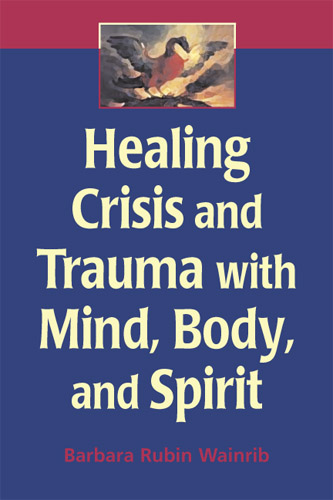 by Barbara Rubin Wainrib, EdD
by Barbara Rubin Wainrib, EdD
This book offers the educator and the practitioner training methods, exercises, and intervention techniques applicable to the gamut of experiences that we currently encounter.
Full Description:
We live in a changed world, a world where the enemy is no longer in uniform on the other side of a trench. There is no longer an identified "war zone" and the "enemy" may be the innocent looking person standing next to us. Clear boundaries and an assumption of safety no longer exist.
Learning new skills to address the injuries incurred by sudden trauma and unpredictable lives is essential. This book is written for those persons in the "helping professions." It is also written for those who have a sufficient understanding of psychology and a sufficient awareness of our current world, and want to gain some knowledge about being helpful.
This book offers the educator and the practitioner training methods, exercises, and intervention techniques applicable to the gamut of experiences that we currently encounter. It also will introduce readers to newer concepts and their applications such as role play, spirituality, the role of animals in healing, and the concept of forgiveness. Throughout the book, whether it is in those who represent the highly resilient or those who continue to struggle, a strengths perspective is emphasized. Finally, this book describes the "Phoenix Phenomenon", a concept Wainrib developed during the course of her teaching and practice, which articulates and illustrates an inherent ability to use resilience in the process of converting pain into growth.
168 pp., Softcover
PREFACE
ACKNOWLEDGMENTS
-
1.UNDERSTANDING CRISIS INTERVENTION AND TRAUMA RESPONSE
-
Introduction: Review of the General Crisis Response
Acknowledging Trauma
Historical Background: Men, Women, and Trauma
Mass Traumas
-
2.UNDERSTANDING TRAUMA AND ITS IMPACT
September 11, 2001: The Psychological Experience: Reaction and Response
Are We All Victims?
Understanding Reactions
Your Reaction
Understanding Trauma
Vicarious Traumatization
Secondary Victims
-
3.MASS TRAUMA, PAST AND PRESENT
Part One: Mass Trauma, Past and Present
The Impact of Mass Trauma
Genocide
The Gacaca Process
Ten Years Later
Creating Hope
Aging Victims of Mass Trauma
Treating Survivors
Long Term Impact of Mass Trauma
Part Two: Tsunami!
Part Three: Who Am I? Lost Identity of Child Trauma Victims: Are We Recreating This Phenomenon?
-
4.WOMEN AND TRAUMA
Why "Women and Trauma"?
Statisitics, Women, and Trauma
The Women and Trauma Project
Trauma and Women's Health
Women, Trauma, and the Military
Homelessness
The Women of Omarska
The Trauma of Forced Migration and War
Diversity
"Peacekeepers"?
-
5.TRAUMA FROM WITHIN: LIFE THREATENING ILLNESS
Impact and Role Change of Therapist
Cancer as Trauma
Population and Treating Modalities
Working with Cancer Patients: Patients' Needs and Therapists' Skills
Gender, Family Systems and Trauma
Palliative Care and Facing Death
-
6.RESILIENCE AND THE PHOENIX PHENOMENON
The Phoenix Phenomenon
Phoenixes Amongst Us
John's Story
Jeff's Story
Senator Max Clelland's Story
Creating Resilience
What Creates "A Phoenix'?
Toughness/Hardiness
Positive Change Following Trauma
The "Second Disaster"
Phoenixes Rising From 9-11
-
7.TRAUMA AND THE MIND
Part One: Experiencing Trauma
Prevalence of Trauma: New Roots, Old Roots
Importance af Early Assessment For PTSD
Part Two: Healing Trauma's Fallout
Current Information on Treatments and Controversies:
The Controversy Over Critical Incident Stress Debriefing
Hypnosis
Cognitive Behavioral Therapy
Acute Interventions After Disaster
Compassion Fatigue
Care for the Caregivers
Preventive Interventions
Other Resources
-
8.TRAUMA AND THE BODY
First Do No Harm: Creating a Safe Place
The Body Remembers
The Body as a Safe Place
Choosing Life Exercises
Other Healing and Affirming Exercises
-
9.SPIRITUALITY AND TRAUMA
Part One: Defining and Understanding Spirituality's Role in Trauma
Part Two: Therapeutic Spirituality: Applying Spirituality to Traumatic Situations
-
10.NEW SOURCES OF HEALING
Part One: Healing the Healers
Assessing Your Own Resources
Defining Healing
Part Two: Reaching Out To Communities
Using the Media in Healing Political Unrest: The Quebec Referendum and the Anglophone
The Clergy Connection
Part Three: Animals and Healing
-
11.FORGIVENESS
Thoughts About Forgiveness
Movements Towards Forgiveness
Physiological Components of Forgiveness
Popularity of the Concept of Forgiveness
When Forgiveness Backfires
-
12.FINAL THOUGHTS
|